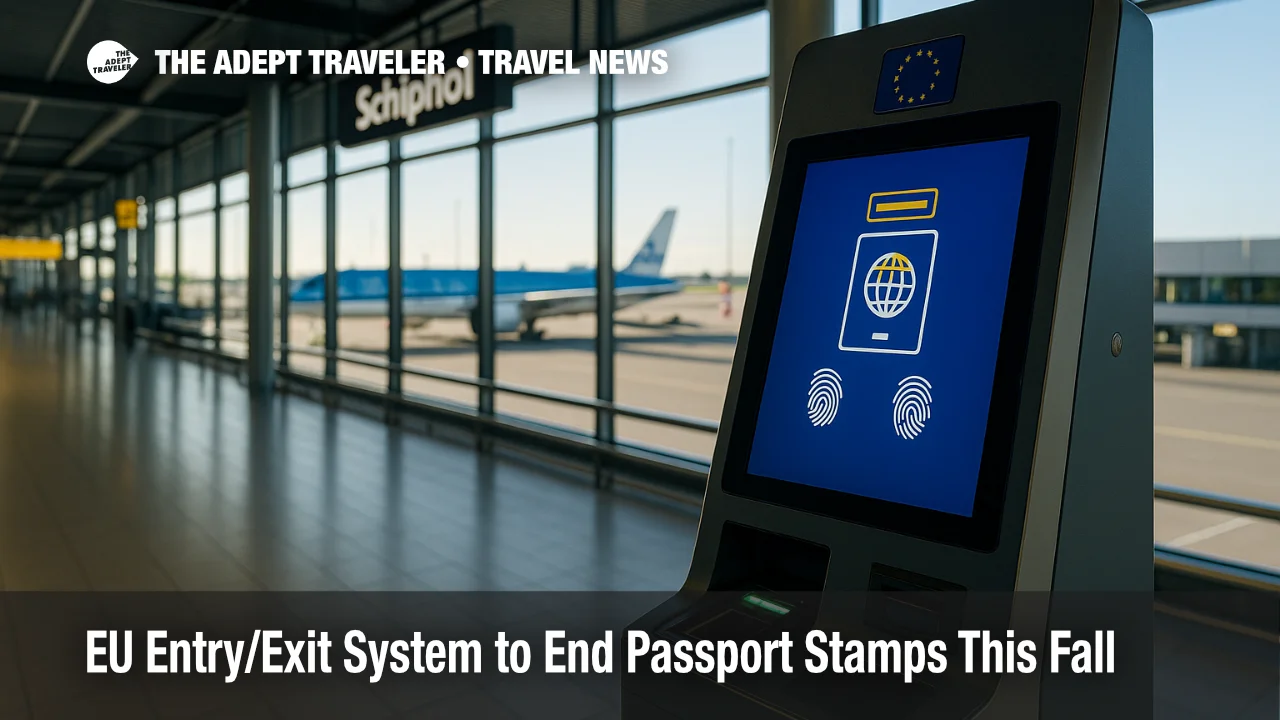EU Entry/Exit System to End Passport Stamps This Fall

The thrill of watching an inked passport fill with international stamps is about to fade for anyone heading to Europe. Beginning October 12, 2025, the European Union will start phasing in its new biometric Entry/Exit System, replacing physical stamps with a digital record of every crossing. Border kiosks will scan passports, faces, and, for most travelers, fingerprints, automatically updating an EU-wide database. Officials say the shift will speed inspections, tighten security, and help track the 90-days-in-180 rule. Full rollout is set for April 10, 2026. Collectors may mourn, but the lines should move faster.
Key Points
- Why it matters: Paper passport stamps disappear for 29 European countries.
- Travel impact: Biometric kiosks will log every entry and exit, enforcing the 90/180-day rule.
- What's next: Gradual rollout begins October 12, with full coverage by April 10, 2026.
- Possible first-day queues while travelers learn the new kiosks.
- Australia and a handful of Asian hubs already use similar stamp-free systems.
Snapshot
The Entry/Exit System (EES) is the EU's biggest border-tech overhaul in decades. It covers the entire Schengen Area plus Bulgaria, Romania, Cyprus, and Ireland's external crossings. Each visit by a non-EU national will generate a time-stamped digital record good for calculating the bloc's 90-day allowance. Facial recognition and fingerprint scans-children under 12 are exempt from fingerprints-will replace the manual ink stamp. EU officials say automated gates can process up to 10 passengers per minute, potentially cutting peak wait times by half. Data will be kept for three years, or five for overstayers, and shared with law-enforcement databases.
Background
Plans for EES date back to 2013, but technical hurdles and cost sharing slowed the project. After multiple delays, the European Commission confirmed October 12, 2025, as the official start date. The system dovetails with ETIAS, the €7 travel authorization now expected by late 2026. Together they aim to seal long-criticized gaps in Schengen border policing, where overstays and fraudulent stamps have been hard to track. France piloted early kiosks at Roissy-Charles de Gaulle, finding a 30 percent reduction in manual checks. Australia scrapped arrival stamps in 2012 and reports few traveler complaints today.
Latest Developments
Rollout timeline and border impact
The European Commission's July 29 press release confirmed that EES hardware-self-service kiosks, fingerprint pads, and live-camera gates-has begun shipping to airports, ports, and land crossings. The first live sites will be at Paris Charles de Gaulle, Madrid-Barajas, and the Slovak-Ukrainian border. Carriers are updating check-in systems so gate agents can warn travelers whose 90-day limit is about to expire. The Commission predicts "limited teething delays" during the first month, especially at ports such as Dover, where space for kiosks is tight. To avoid bottlenecks, travelers may pre-enroll biometric data through a secure smartphone app, pending national approval. Press release, European Commission
Analysis
Ending passport stamps marks a cultural shift as much as a procedural one. For generations, stamped pages served both as souvenirs and as fall-back proof of legal entry. Digital records should remove guesswork, yet they also require absolute system uptime and airtight data security. Schengen front-line officers welcome the automated counters, citing chronic understaffing at busy airports. Privacy advocates remain cautious, noting that millions of biometric files will be stored in a central database vulnerable to breaches. Airlines face new liabilities for boarding passengers who exceed their stay; tech integrations must flag risk in real time. Still, most travelers will notice only a new ritual-place the passport, stare at the camera, and walk through. For stamp collectors, a chunky exit receipt may replace that coveted ink mark, but the EU's bet is that convenience will outweigh nostalgia.
Final Thoughts
If your European vacation falls after October 12, expect sleek kiosks rather than an immigration officer's rubber stamp. Arrive early during the transition, keep your eyes on the 90-day clock, and save a digital copy of each crossing for your records. The souvenir may be gone, but streamlined borders and improved security promise a smoother journey-and that trade-off might be worth the loss of those beloved passport stamps.
